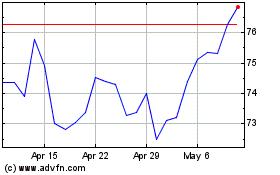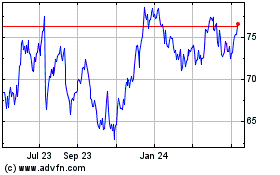Big Banks Tweak Business Plans to Avert New Regulator Costs -- 3rd Update
October 04 2016 - 7:55PM
Dow Jones News
By Donna Borak and Emily Glazer
Five of the country's biggest banks detailed tweaks to their
business models in hopes of persuading regulators they could absorb
significant financial distress without requiring taxpayer funds to
stay afloat.
The stakes are high for J.P. Morgan Chase & Co., Bank of
America Corp., and three others. If regulators deem these revisions
of their so-called living wills -- made public by the government
Tuesday -- to be insufficiently credible, those institutions could
be ordered to hold higher levels of capital on their books, or to
restructure and shed business lines.
Regulators are facing considerable pressure from politicians to
use this process to break up the biggest banks, with many --
notably Massachusetts Democratic Sen. Elizabeth Warren -- arguing
these institutions remain "too big to fail."
Federal regulators had declared in April that earlier plans
submitted by those two banks -- along with Wells Fargo & Co.,
Bank of New York Mellon Corp., and State Street Corp.--didn't show
sufficiently how they could wind down their operations in an
orderly fashion, and told them to address weaknesses by Oct. 1.
In the latest public versions of the plans -- each running
around 50 pages -- the firms laid out modest changes to their
business operations to address what regulators had branded
"deficiencies" in their original documents, such as giving more
detailed explanations for how they would unload assets, or putting
top managers in charge of bankruptcy planning. The firms also
submitted considerably longer living wills that won't be made
public.
The agencies in charge of the process -- the Federal Reserve and
the Federal Deposit Insurance Corp.--said in a press release they
hadn't yet reviewed the plans and "will now be initiating their
process for review." The agencies didn't say how long the process
would take.
The living wills requirement was created by the 2010 Dodd-Frank
financial overhaul law, enacted in the wake of the financial crisis
to, among other things, prevent a recurrence of government bank
bailouts.
This is the third round for the major banks. In 2012, they
submitted plans but didn't get any individual feedback. In 2014,
the Fed and FDIC rejected all the plans. This year, they kicked
back five, seeking revisions, and cleared three -- from Goldman
Sachs Group. Inc., Morgan Stanley and Citigroup Inc.--though the
regulators still said those plans had "weaknesses" and
"shortcomings." Those three firms submitted updated plans that were
also made public Tuesday.
J.P. Morgan said it had altered its business organization to
create a new "intermediate holding company" and has moved assets
into the unit, which would be ready to inject immediately capital
and liquidity into distressed subsidiaries. Bank of America said it
had moved assets into a pre-existing intermediate company for this
purpose.
These moves are aimed at meeting regulator questions about the
banks' abilities to estimate liquidity resources and needs in times
of stress, and the lack of a formal agreement to assure support for
those subsidiaries.
J.P. Morgan also said it had identified 16 "objects of sale"
along with potential buyers who could pick up the properties
quickly.
Wells Fargo said it, too, had crafted a more detailed playbook
for potential "strategic sale transactions." And the bank said it
is giving more responsibility for living will planning to top
executives. Wells Fargo President Timothy J. Sloan now oversees all
recovery and resolution planning initiatives. Chief Financial
Officer John Shrewsberry now leads the formal management governance
committee related to living wills, and that committee now includes
senior executives from "key support groups" including the bank's
controller, head of corporate enterprise risk and the chief
technology officer.
If regulators don't consider those moves sufficient, they now
have the power to raise capital requirements or even force
divestitures, as they see fit. Both agencies -- the Fed and FDIC --
would have to agree on whether the proposed fixes by the firms are
adequate, and if not, what the appropriate action would be to
take.
There is no set time frame on when they must reach a
decision.
"It's all about starting the clock to give the agencies the
authority to use some powerful tools if banks are unable to
remediate those deficiencies," said John Simonson, a principle at
consulting firm PwC and a former FDIC official.
John Carney contributed to this article.
Write to Donna Borak at donna.borak@wsj.com and Emily Glazer at
emily.glazer@wsj.com
(END) Dow Jones Newswires
October 04, 2016 19:40 ET (23:40 GMT)
Copyright (c) 2016 Dow Jones & Company, Inc.
State Street (NYSE:STT)
Historical Stock Chart
From Jun 2024 to Jul 2024

State Street (NYSE:STT)
Historical Stock Chart
From Jul 2023 to Jul 2024
